We use cookies to ensure you get the best browsing experience. By continued use, you agree to our privacy policy and accept our use of such cookies. For further information, click FIND OUT MORE.
Southeast Asia sits at the forefront from climate change, which results in prolonged periods of drought and extreme weather events. More often than not, these problems translate to water, and water, more often than not, points to issues of gender. In this Women’s Month report, the Philippines’ GMA Integrated News, Indonesia’s Magdalene, and Timor Leste’s Neon Metin, with support from International Media Support, look at how the water crisis affects women and children, and how they themselves are finding the solutions to the problem.
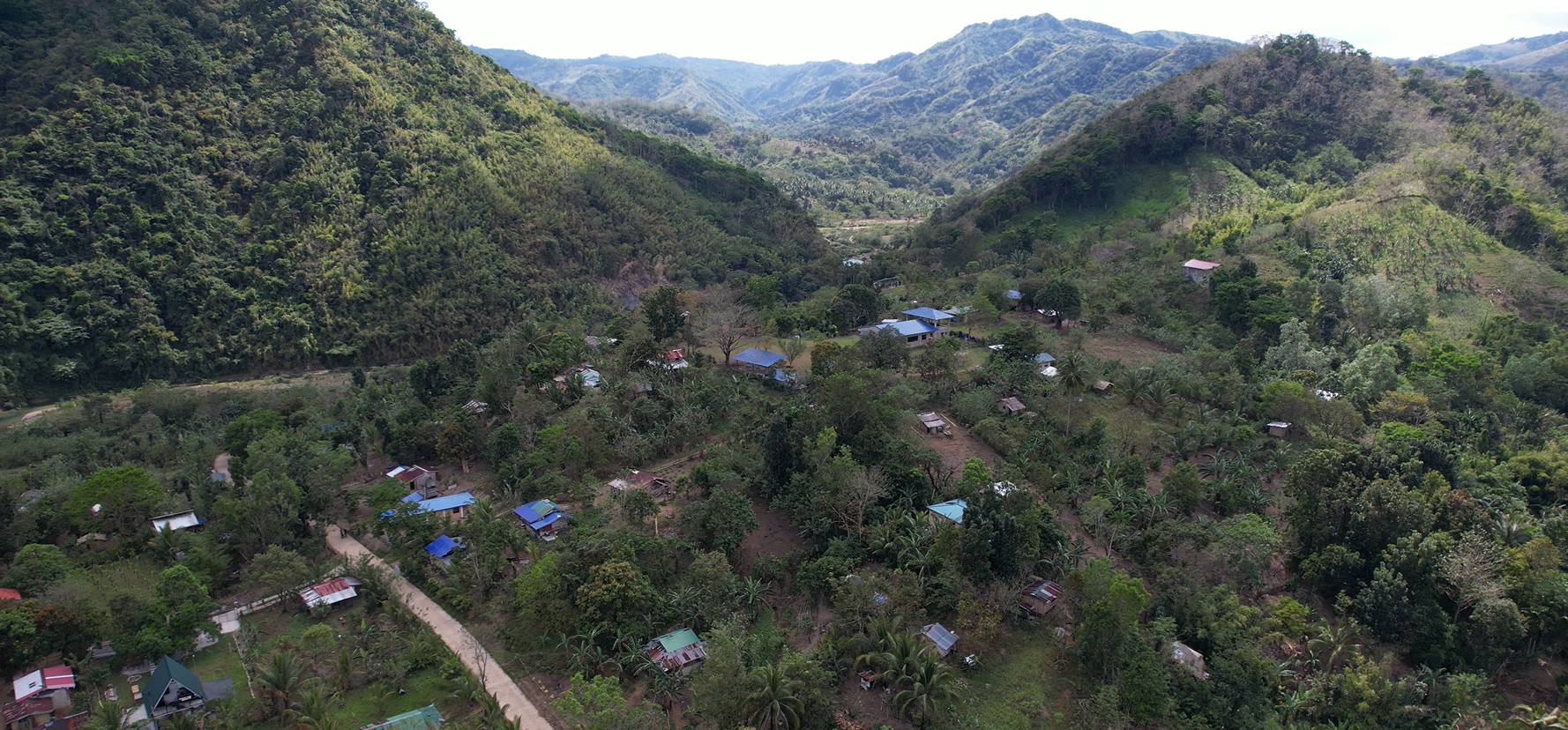
Water has always been hard to come by Sitio Linamas of Barangay Romongaob, South Upi, Maguindanao del Sur, but it’s especially difficult these days. It hasn’t rained for more than two months.
Residents have taken it upon themselves to find water, digging up land by the rice fields to try and see if there is enough groundwater that could produce a spring.
“Nag-try maghukay. Nagbakasakali sila, pero wala talagang source of water,” Aileen Quesa Marie Hualde tells the Digidokyu team. The leader of the Teduray indigenous people and founder of the Women Organization of Rajah Mamalu Descendants points to various locations in the rice and corn field showing the residents’ efforts to come up with solutions to the water crisis.
There is only one spring in the Sitio where residents normally rely on for their daily needs, supplemented by an extra 30-minute walk to the nearest Bayan to buy potable water from refilling stations.
But it’s gotten so dry that they now also have to buy water for bathing purposes.
“Nag-aagawan na,” Hualde said, adding “sometimes, 'yung aming panligo, binibili na talaga namin sa town proper and even 'yung aming drinking water kasi nga, medyo short. Nagkaroon na ng shortage.”
At the moment, it is not unusual to see residents lining up at the spring as early as 3 a.m. just to fetch water. In fact, Hualde adds, there is a line for water “until afternoon, hanggang gabi pa.”
The water isn’t especially clean, but the residents make do with it for their washing and cooking, even for bathing.
“Okay lang kung tag-ulan,” Hualde continues, “pero, ewan. Dito sa lugar namin, we are not lucky na magkaroon kami ng water system.”
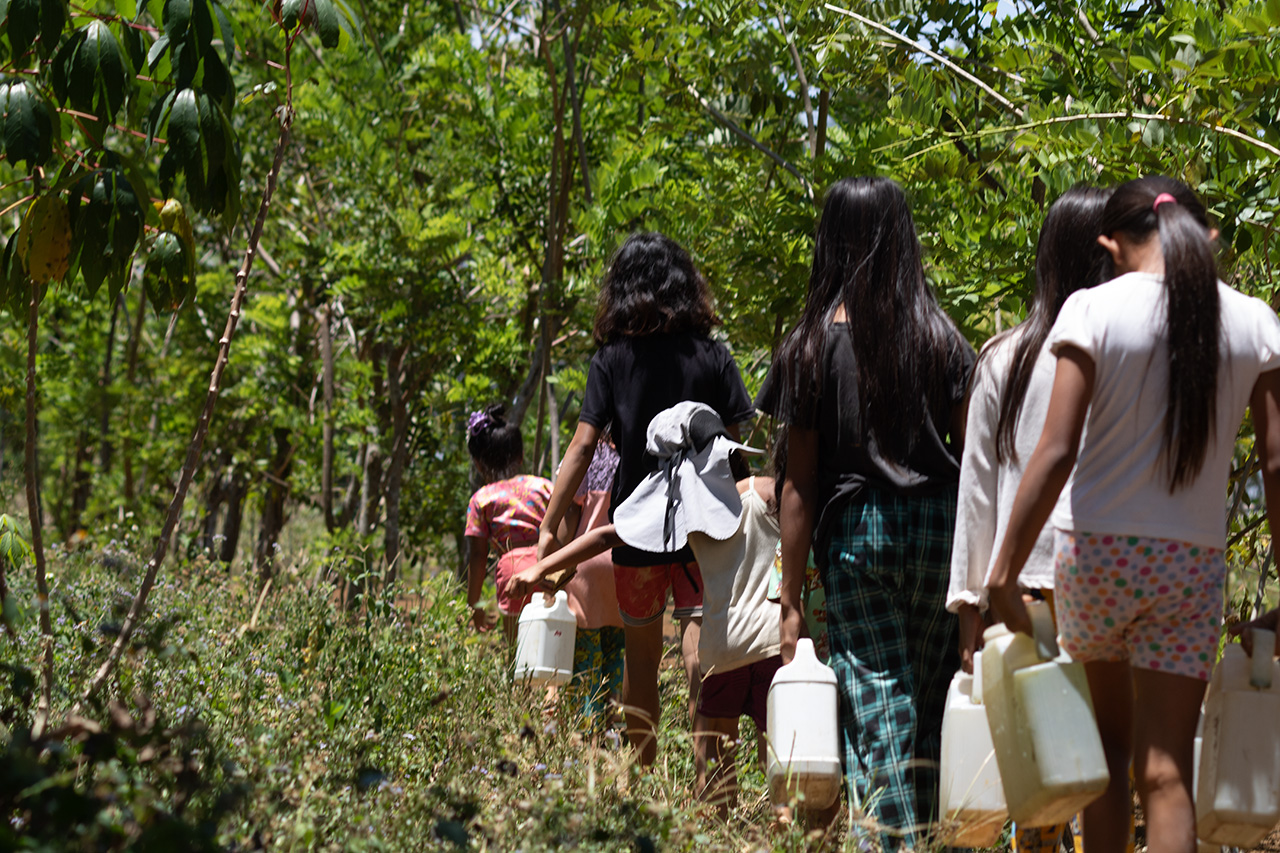
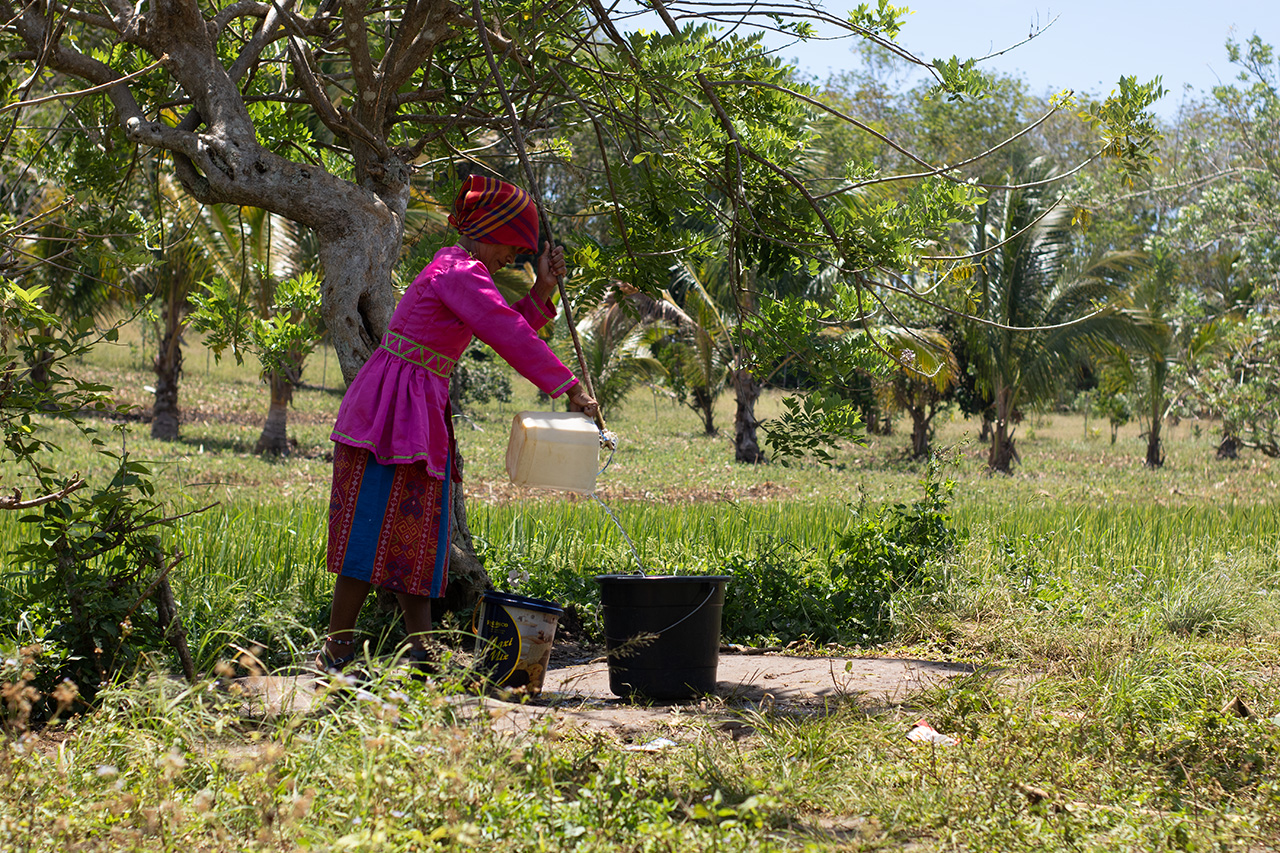
Barangay Laiban in Tanay, Rizal is yet another water-unlucky community where water-borne illnesses like diarrhea are affecting residents. Like the Terudays of Maguindanao, the Dumagat-Remontados of Sitio Old Laiban in Barangay Laiban also go on 30-minute treks daily for their supply of water.
According to Nanay Rosalyn, a Dumagat-Remuntado who has lived her whole life in Sitio Old Laiban such is life in the mountains. “Mahirap.”
Water for her doesn’t just require the 30-minute walk. It also requires extra filtering, as the water is exposed to elements.
It’s much better these days, Nanay Rosalyn says, after the barangay received donations to make water a lot more accessible to them. There is now a hose nearer her house linking them to the water source from far away, apart from a drum, where they store water.
They only recently got into the habit of boiling water, after a neighbor’s child experienced diarrhea. “Nung nakaraan na buwan, may nagtae na bata. Pina-check up doon sa doktor, ang sabi, sa tubig daw,” she narrates.
Her neighbor and sister, Rowena, has it much worse: Her 10-month old grandchild died after drinking water they collected from the spring.
“Nagdudumi siya, nagduduwal, natuyuan na 'yung katawan,” she said. They attempted to heal the baby with medicinal herbs that elders of their ethnic group have prescribed and long practiced, but after 24 hours, the baby expired. “Hindi na umabot sa duktor,” Nanay Rowena said.
They have since started buying mineral water from the bayan, but when that proves too expensive, the doctor advised them to include an additional step of boiling the water.
Women are most likely to be responsible for fetching water for households, while girls are nearly twice as likely as boys to bear the responsibility, and spend more time doing it each day. —UNICEF
The difficult situations involving water in the Philippines are not uncommon in many parts of the world. According to a July 2023 joint report by UNICEF and the World Health Organization, some 1.8 billion people live in households without water supplies on the premises.
Meg Manzano of Waves for Water Philippines illustrates the problem. “[Mula] sa living room ko [papuntang] kusina namin, siguro, 10 steps po. Maglalakad po ako ng 10 steps tapos, meron na po akong clean drinking water. Pero sa mga ibang underserved ng mga communities na, na-encounter po namin, para po sa kanila, on average po, mga six kilometers and kailangan nilang ilakad para lang kumuha ng tubig na maininom. So kung sa number of steps, siguro higit na mga 5,000 to 6,000 steps po 'yun.”
In an archipelago like the Philippines, accessing water sometimes means going on at least a 90-minute boat ride. “Minsan nga, mga three hours pa para lang makakuha ng tubig sa ibang isla,” she says.
Established in 2009 in Indonesia by American pro-surfer Jon Rose, Waves for Water (W4W) is a targeted, special-ops style, non-profit organization that set up an office in the Philippines in 2013 with the aim of providing clean water access to Filipinos with its portable filtration system. Barangay Laiban in Tanay, Rizal, and Linamas of Barangay Romongaob are just a couple of W4W communities in the Philippines.
But apart from giving far-flung communities access to clean, drinking water, W4W is also present during disasters like typhoons and earthquakes to help provide water relief.
A W4W bucket can last up to 10 years, and require no electricity. It has FDA and DOH certification to ensure the water produced from its portable water filtration is clean.
The unfortunate truth is that more often than not, the additional 6,000 steps or the extra 90-minute boat ride fall on women and children.
According to the UNICEF report, “women are most likely to be responsible for fetching water for households, while girls are nearly twice as likely as boys to bear the responsibility, and spend more time doing it each day.”
It adds, “Women and girls aged 15 and older are primarily responsible for water collection in 7 out of 10 such households, compared with 3 in 10 households for their male peers. Girls under 15 (7%) are also more likely than boys under 15 (4%) to fetch water. In most cases, women and girls make longer journeys to collect it, losing time in education, work, and leisure, and putting themselves at risk of physical injury and dangers on the way.”
Professor Babette Resurreccion, who teaches Global Developmental Studies, centering on gender, feminism, and environmental at the Queens University in Canada, recalls one of her researches where she came across a community of informal settlers.
“What was highlighted in that case was not so much that water was scarce but the fact that the people in informal settlements would have to resort to illegal water connections, largely because of their status, and of course, it fell on the women’s shoulders to actually try to provide drinking water for their families, since they provide food and provide water to their families.”
In that case, Resurreccion says the women illegally connected to a middle person, who charged them with a fee. “They had no other recourse,” Resurreccion said. “They had no other choice so they had to do that.”
Over Zoom, Resurreccion tells GMA News Online, “it affects women adversely because of their care obligations at home. To provide water. So sila naapektuan mostly."
That’s not mentioning the personal needs that come with being a woman. “Mas dapat mataas 'yung [water needs ng] personal hygiene ng kababaihan, lalong-lalo na tuwing kami ay may buwan ng dalaw,” Hualde said as she points out all the other household chores requiring water that fall on a woman’s shoulders: rearing children, cooking food, laundry and housekeeping, as well as gardening.
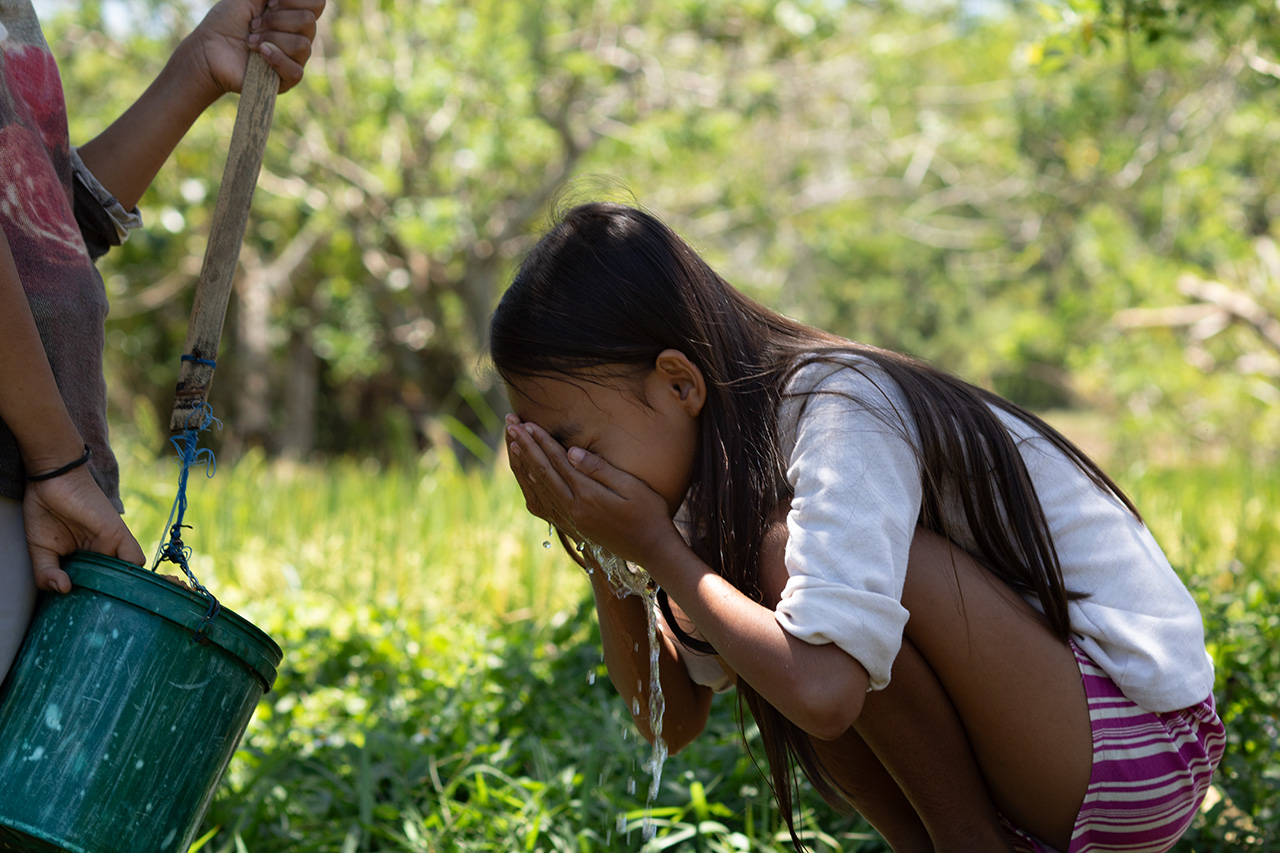
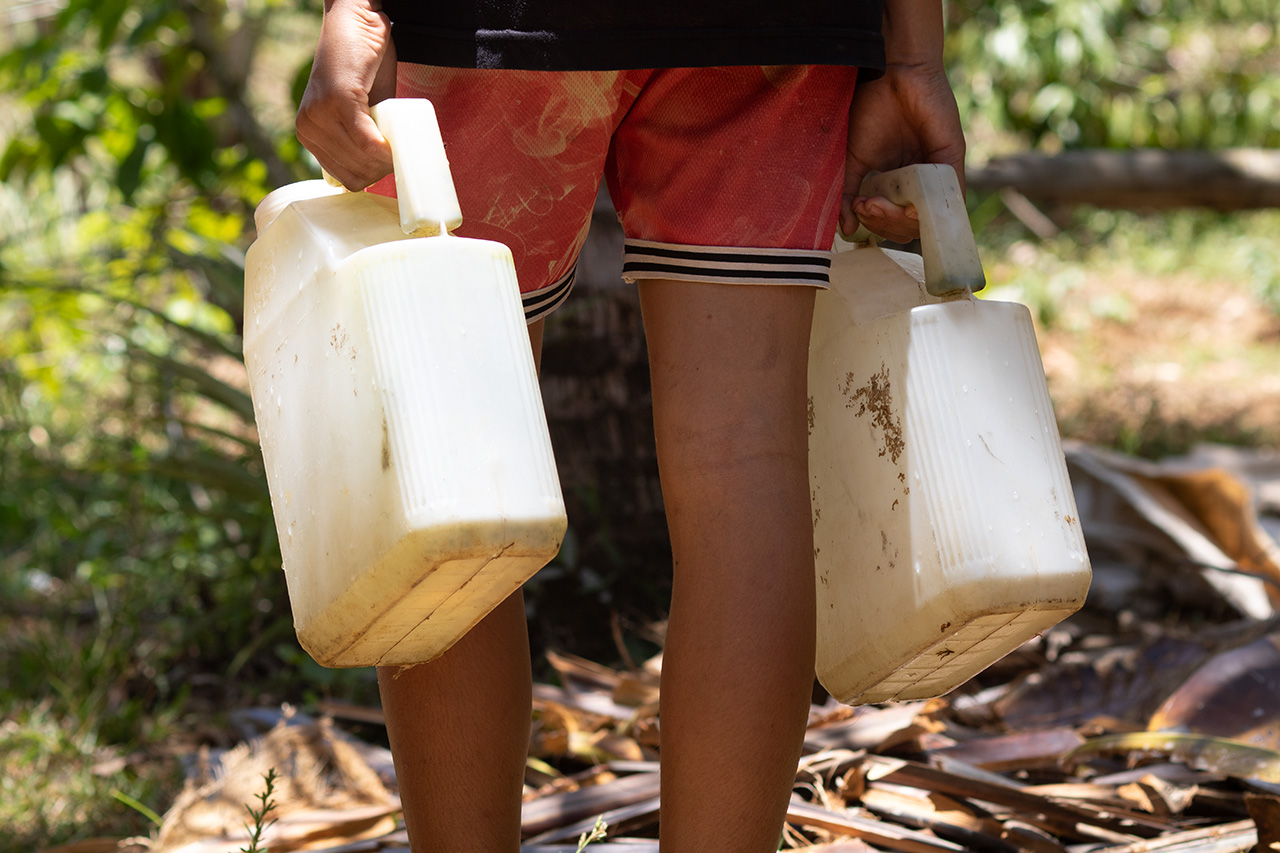
Manzano recalls an experience in Palawan when Barangay health workers would request an additional P200. “Pambili ng mineral water para makatulong sa pagpapaanak,” she said. “Para po sigurado na 'yung gagalitin po dun sa nanay po is malinis.”
According to a 2023 World Resources Institute (WRI) report, the Philippines is ranked 76 out of 164 countries currently experiencing medium-high water stress, together with Indonesia, which is at 55. Timor-Leste, ranked 80, is currently experiencing low-medium water stress.
Without intervention, the situation is bound to worsen in 2050, with the Philippines projected to go up to 63. Indonesia is projected to go down the water stress ranking to 76, while Timor Leste is projected to stay put at 80.
“The definition is that, if you are below 1700 cubic meters per person, then you are already experiencing water stress,” UNICEF's Wash Program Specialist Mira Bacatan clarifies to GMA News Online, adding the 2017 report from WRI showed the Philippines recorded just 1300 cubic meters per person.
There are several water-stress zones in the country, she adds. “There’s 21 ground water stress zones and then 15 water stress river basin,” Bacatan says.
Water stress, the ratio of water demand to renewable supply, measures the competition over local water resources. —World Resources Institute
According to Bacatan, waster stress is often attributed to urbanization, growing population, industries, tourism, and definitely climate change.
“When you hear water stress, it doesn’t equate to water crisis,” she explains. “Hindi siya immediate water crisis agad. But if you don’t act on the water stress, it could lead to a water crisis in the end.”
Resurreccion warns: “If you have a situation of inequality, of gender and inequality, it will probably be the case that women might be most adversely affected.”
The United Nations University Institute for Water, Environment and Health said there are a whopping 4.3 billion people living in countries across the Asia Pacific Region that are considered water insecure. They include the Philippines, Indonesia and Timor Leste which scored 58, 51, and 42 respectively.
Water Security means “the adaptive capacity to safeguard the sustainable availability of, access to, and safe use of an adequate, reliable and resilient quantity and quality of water for health, livelihoods, ecosystems and productive economies.”
Interestingly however, it is women in Southeast Asia who are finding solutions to the water crisis themselves.
In the south-central part of Java, some 553.5 km away from Jakarta, Indonesia is Yogyakarta.
Famous for classical Javanese fine arts, Yogyakarta is among the most must-visit places in Indonesia. Its tourism industry is always on the upswing, which is exactly why it is among the regions in Indonesia experiencing drought and water crisis.
While the local government tries to find solutions to the problem by using a tanker to supply clean water to its citizens, a group of women in the Sleman Regency of Yogyakarta thought that wasn’t a real solution, as “the problem keeps happening [in] the next few years."
That’s how the Banya Bening Rainwater Community (BBRC) came together.
According to Indonesian website Magdalene, the BBRC is a women-led collective that looks at rainwater as a solution to the problem.
“Every year, the local government supplies clean water to the citizens by using a tanker with a capacity of 5,000 liters,” Sri Wahyuningsih, the head of Banyu Bening Rainwater Community tells Magdalene.
“But the problem keeps happening for the next few years. That’s why Banyu Bening Rainwater Community tries to educate the public, so they know how to solve the problem by utilizing rainwater and not asking for the supply.”
The BBRC is comprised of women from different backgrounds, that one way or another relate to the water problems that occur every year — floods, droughts, or the water crisis itself — who would “like to make a small contribution to society, by solving the water problem.”
While a lot of their activities are centered on educating people that rainwater is actually a resource and teaching interested participants on how to harvest and filter rain using two different methods, BBRC is also helping people realize the bigger solution: how not to contribute to the water crisis.
”That is important, so our understanding isn’t only how to utilize the abundant rainwater that is free and easily accessible. We need to change ourselves by not becoming the object that causes the crises.”
In Timor Leste meanwhile, organizations like the Timor-Leste Organic Fertilise (TILOFE) are turning to indigenous practices to conserve water like Debu. Much like Indonesia’s rainwater harvesting, the practice of Debu will have people digging the ground to form a pit that will collect rainwater. When there is enough rainwater, a pipe will be placed in the put to filter the collected water, and take the filtered water for use.
According to Neon Metin, the sub-village of Palimanu is among the most affected of the clean water crisis in Timor Leste, but creating Debu helped ease the problem.
Martinha Maia, a woman resident of Palimanu said she no longer needed to walk long distances to look for water, with adequate water supply to help her grow vegetables that she sells in the market.
When Typhoon Odette made landfall, caused havoc, and forced San Vicente, Palawan to declare a state of calamity in December 2021, it was a woman who took it upon herself to call for help, get organized and send help to various communities.
Minda Rodriguez had only been living in San Vicente, Palawan for about four years, moving to Barangay New Agutayo because “sabi nila, sa Palawan, walang bagyo, walang lindol, and technically, we’ve been looking for a place like that.”
And then Odette happened. It was their first typhoon experience of a typhoon in their chosen home and according to the freelance producer, it was also the first typhoon experience for most of San Vicente. “Forty years, it’s never happened here,” she said.
She remembers Odette whipping them hard and fast at dusk on December 17. “Nung medyo dumilim na, lumilipad na 'yung mga kahoy. Literal 'yung mga puno were really flying,” Minda recalls, adding her husband had to move the car mga three times kasi magtatalsikan na ng mga kahoy. Nakikita namin 'yung niyog from the other property, natutumba na. Ganun na siyang kalakas.”
Things calmed to a still, enough for Minda and her husband JP to go outside and have coffee. Then Odette came roaring back 30 minutes later, stronger, angrier and wilder than her first appearance. “It was the second wind that took a lot of roofs in San Vicente. Hindi namin in-expect na iikot yung hangin,” she said.
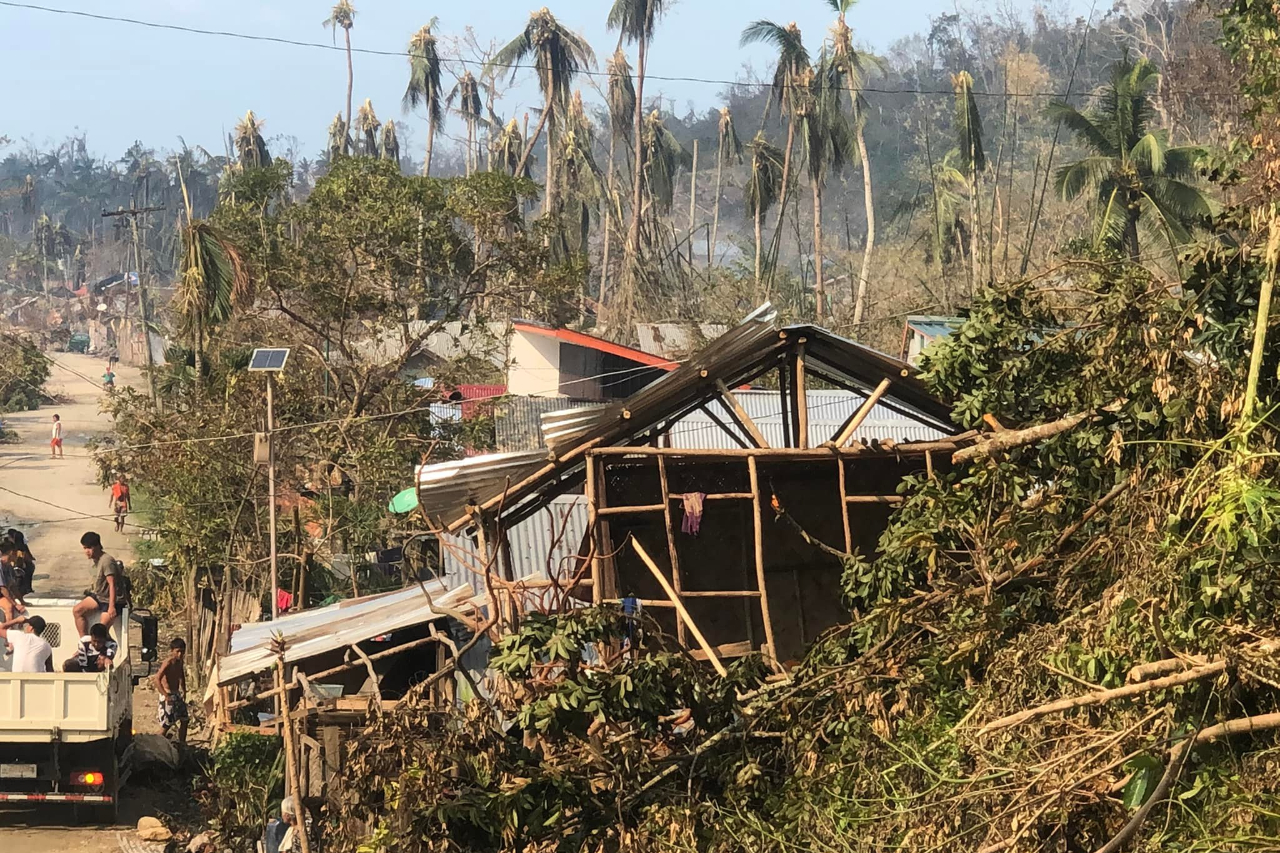
Photo: Minda Rodriguez
Extreme weather isn’t foreign to Minda, who was in Tacloban when Haiyan hit in 2013. Bad weather conditions, too, aren't new to her or to her husband, JP, who is a former member of the Philippine Coast Guard.
Their professional training came in handy; with Minda as producer and her husband from the Coast Guard, they knew to prepare beforehand. They had filled their tank with water, strengthened their roofs, and even went around town to warn people of the impending storm but “hindi lang rin nila in-expect na ganung kalakas 'yun."
Besides, no preparation would have been enough because Odette was really just too strong.
“Napalibutan na ko ng tatlong ipo-ipo but Odette was the most scared that I ever felt,” she said. The storm’s wind rendered sleep impossible, as their house kept shaking through it all. Minda describes it “like it was spaceship, feeling mo lilipad ka na.”
When Odette finally left the Philippine Area of Responsibility at 11 a.m. on December 18, Minda and JP rode their motorcycle through town to survey the damages. “It was really devastation,” she said.
If you have a situation of inequality, of gender and inequality, it will probably be the case that women might be most adversely affected. —Professor Babette Resurreccion, Queens University in Canada
According to the official website of San Vicente, nearly 4,000 houses were destroyed in 10 barangays. There was one dead and 31 injured. An estimated P28 million damages to agriculture was incurred. Water, electricity, and signal were lost.
“Walang tubig kasi nasira 'yung tubig from the main tubing line,” she recalled. And while “the major, major problem was water,” she and her husband got lucky because their house, which was just six minutes away from the mountains, means they were near enough the river to fetch water.
They unloaded their medical kids of aquatabs, tablets you put in water to purify it and make it potable, and got sorted.
Remembering the intermittent internet signal they would sometimes get on their roof, Minda climbed up and luckily saw one bar of signal. I was able to call for help,” she said.
On December 20, she posted on Facebook to inform her friends that they were alive, and that San Vincente needed help. Then she left her phone up there to keep the line of communication open, later on becoming a community hotline of sorts.
That Facebook post reached a lot of her friends who quickly sent help — supply of aquatabs — through the emergency flights to San Vicente.
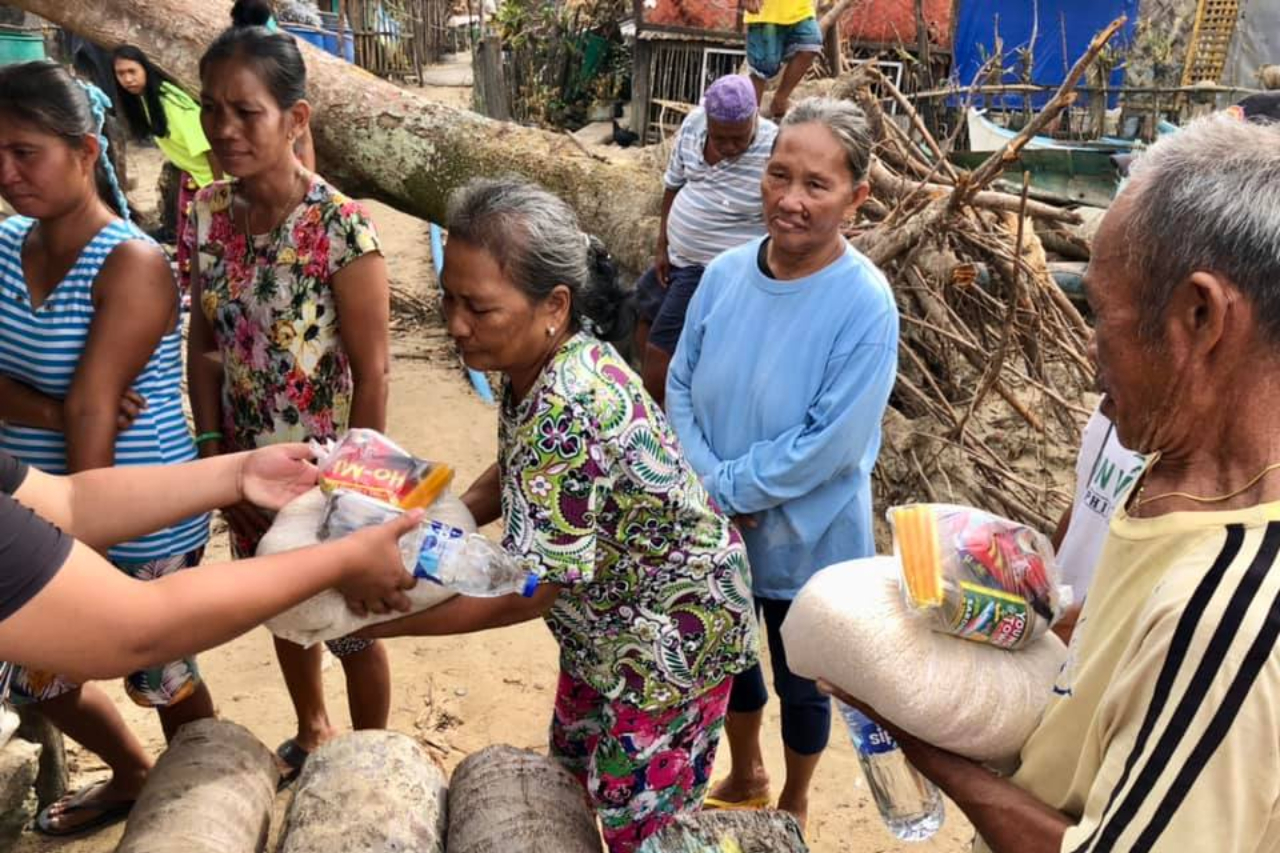
Photos: Minda Rodriguez
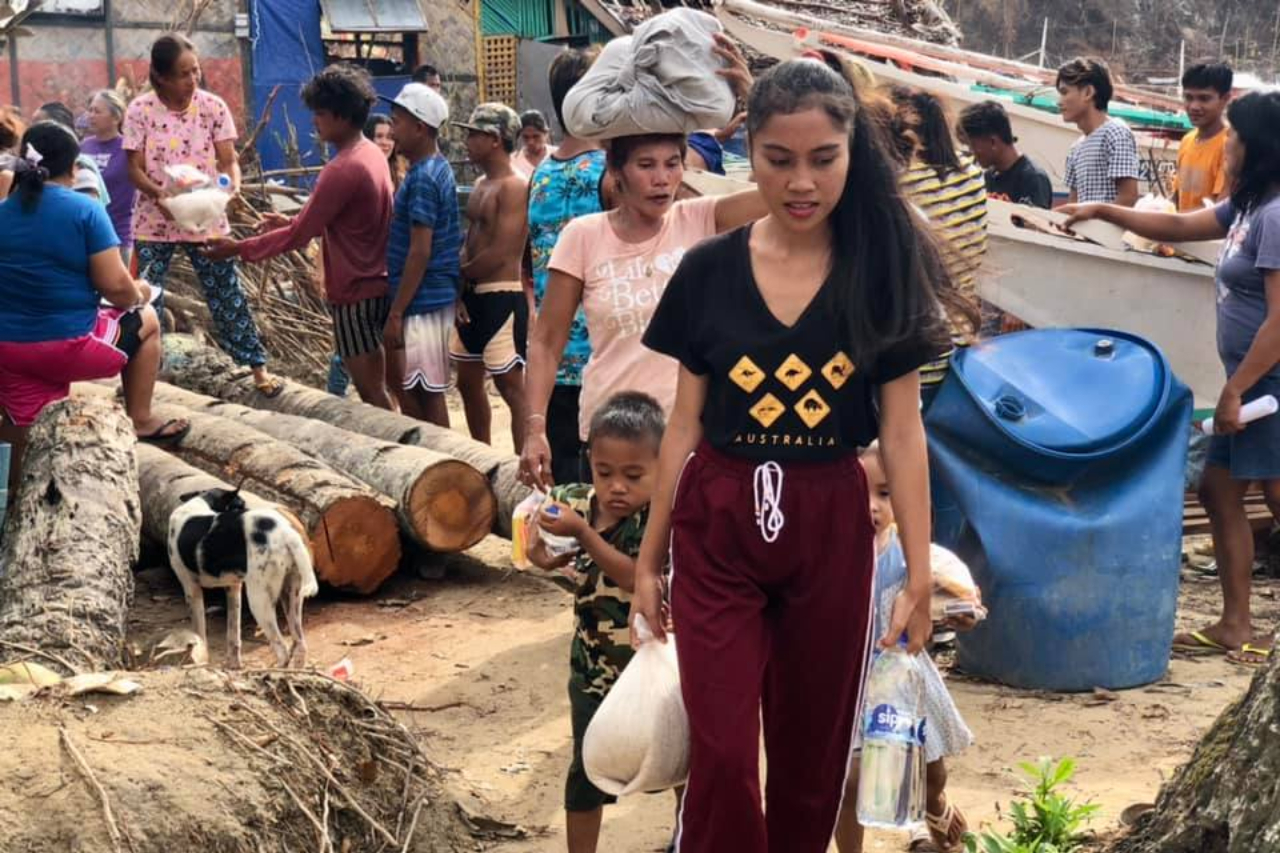
San Vicente was declared under a state of calamity on December 21, and almost instinctively, Minda knew she needed to help.
“So 'yung mga taong nagiigib dito sa bundok, kasi dadaan sa labas namin, nagbibigay kami ng aquatabs para sa pang-inom nila,” she shared.
Another friend, Carlo Delantar of Waves for Water Philippines, sent her a bucket, which she positioned by the river "para sa mga nag-iigib ng tubig sa bundok.”
She took a photo and thanked Delantar, who decided to send her a dozen more.
Meanwhile, Minda and her husband set about remote islands where fishing villages like Babay-Daraga and Casoyan, where the fishermen performed their usual bad weather routine, assembling their boats in a safe cove.
“Pagdating namin, ‘oh my god wala talagang everything’,” Minda said. “Wala na 'yung mga boats nila, wala rin silang access to help.”
The fishing villages only had a well but “for the longest time, 'yung mga balong iyon, hindi naman nila iniinuman. That’s water for other purposes and paubos na 'yung tubig.”
When the dozen W4W buckets arrived, "'yung ginawa ko, for example sa Casoyan, may dalawang balon. Ang nangyari doon ay, isang balon, isang balde,” Minda said.
But help didn’t stop there. Minda had to teach them how to use the buckets, advised them “na pang-community ito. Ang sabi namin, magbayanihan kayo, lagyan ninyo ng — bahay-bahay itong baldeng to para pag may nagiigib, dun na kukuha ng water” and demonstrate how it worked.
It came with comedic relief on the side. “When you convince people this works, you have to be the one to try it eh. Hindi mo pwedeng ipasubok sa iba. Paano mo masisigurado sa kanila na hindi sila mamamatay 'pag inumin nila 'yung tubig na 'yan di ba,” Minda said.
“Nagtinginan kaming mag-asawa. O, bato-bato pick, sino iinom. Cheers! Pagkatapos, na-amaze sila. Inom din sila. The next day, I asked kamusta naman. OK daw. Buhay naman daw sila,” she narrated.
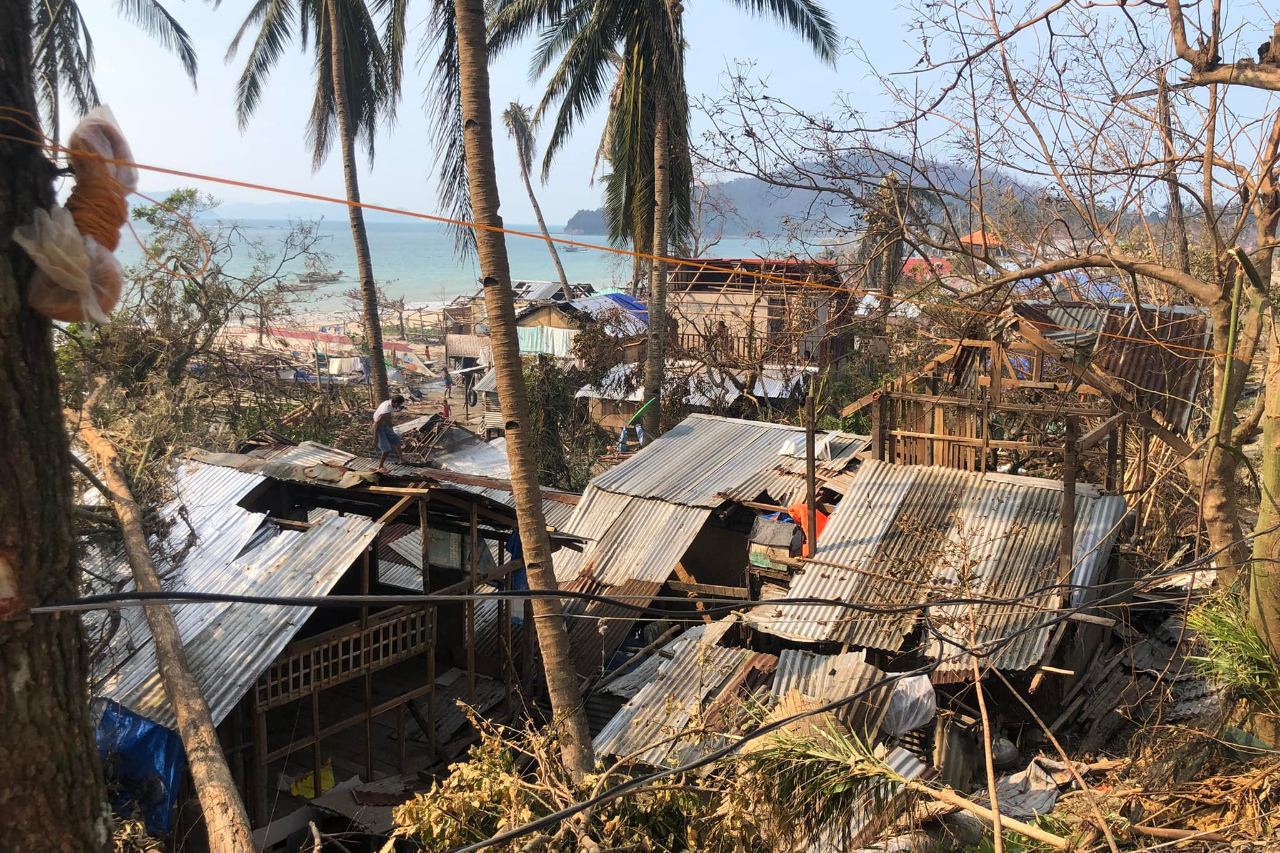
Photo: Minda Rodriguez
Before ordering the creation of the Water Resources Management Office (WRMO) in April 2023, President Ferdinand “Bongbong" Marcos Jr., said the Philippines was experiencing a water crisis.
At the 6th Water Philippines Conference and Exposition in March 2023, Marcos mentioned "stratagems" for water treatment and flood control projects, among others, which are needed to address the problem with water.
Marcos specifically cited the need to build dikes and dams as part of flood control measures.
Under the Department of Environment and Natural Resources, the WRMO’s first action should be to reduce the country’s reliance on groundwater and deep wells as well as managing surface water supply, Marcos said.
He added the WRMO “shall ensure the immediate implementation of the Integrated Water Resources Management in line with the United Nations Sustainable Development Goals and formulate a corresponding Water Resources Master Plan."
All this is a welcome initiative, Bacatan says, because the Philippines is so fragmented when it comes to water.
“When we tried to map it, I think we came up with 31 agencies that have, one way or another, a role to play when it comes to the water sector,” she says. “There’s no one agency giving the overall strategic direction or command.”
Still, they would have preferred having a Department of Water Resources (DWR). “That’s a standing bill in congress right now. It’s been there for over a decade and it’s just re-passed or refiled every time the congress opens. It’s a tough governance problem that we have here in the Philippines,” she said.
Bacatan adds, having a “significant investment in water infrastructure” is important because “hindi na tenable all the time that we draw water underground. We might have to rethink what other sources we could be employing.”
Philippine water concessionaire Maynilad has piloted a new filtration system to make waste water reusable and potable again. “It’s a first in the country. And It’s good because you are not wasting your water. You’re actually harvesting your waste water to reuse it again for something better,” Bacatan observes.
She adds, “ang water hindi siya politically bounded. Water is ecosystem based, dapat ang pagtingin. Kung sino ang andan sa tuktok ng bundok, how they are using it affects those na naroon sa baba. So kailangan, ang planning for water, hindi lang per province. You have to look at it — how does it look like in an ecosystem?”
“In the whole grand scheme of things. Kailangan mas holistic 'yung pagpaplano sa water natin,” she reminds.
Access to and availability of water is among the 17 Sustainable Development Goals of the United Nations. It doesn’t just aim for universal and equitable access to clean water by 2030, but also aims to achieve adequate and equitable sanitation and hygiene for all, with special attention given to the needs of women and girls.
Nine years since it was adopted by the member states, some 2.2 billion people still lack access to clean drinking water. Women and girls continue to bear the brunt.
Climate change is exacerbating the problem, with longer periods of drought and extreme weather events already being experienced. Nanay Rosalyn, Nanay Rowena, and the Teduray community of Maguindanao will need to prepare walking more than the extra 30 minutes to find water. Those 6,000 extra steps may not just be 6,000 extra steps for long. —JCB, GMA Integrated News
This work was produced with support from the International Media Support in partnership with UNESCO.
